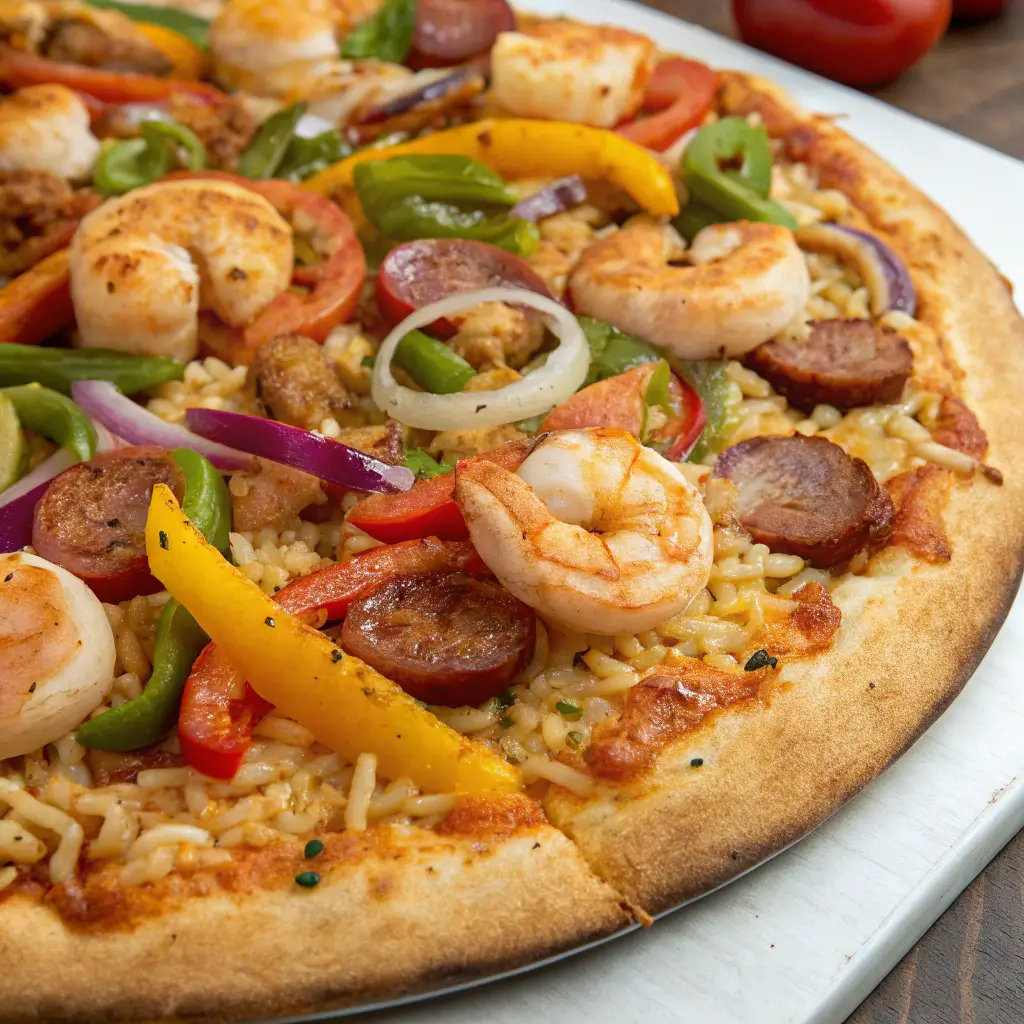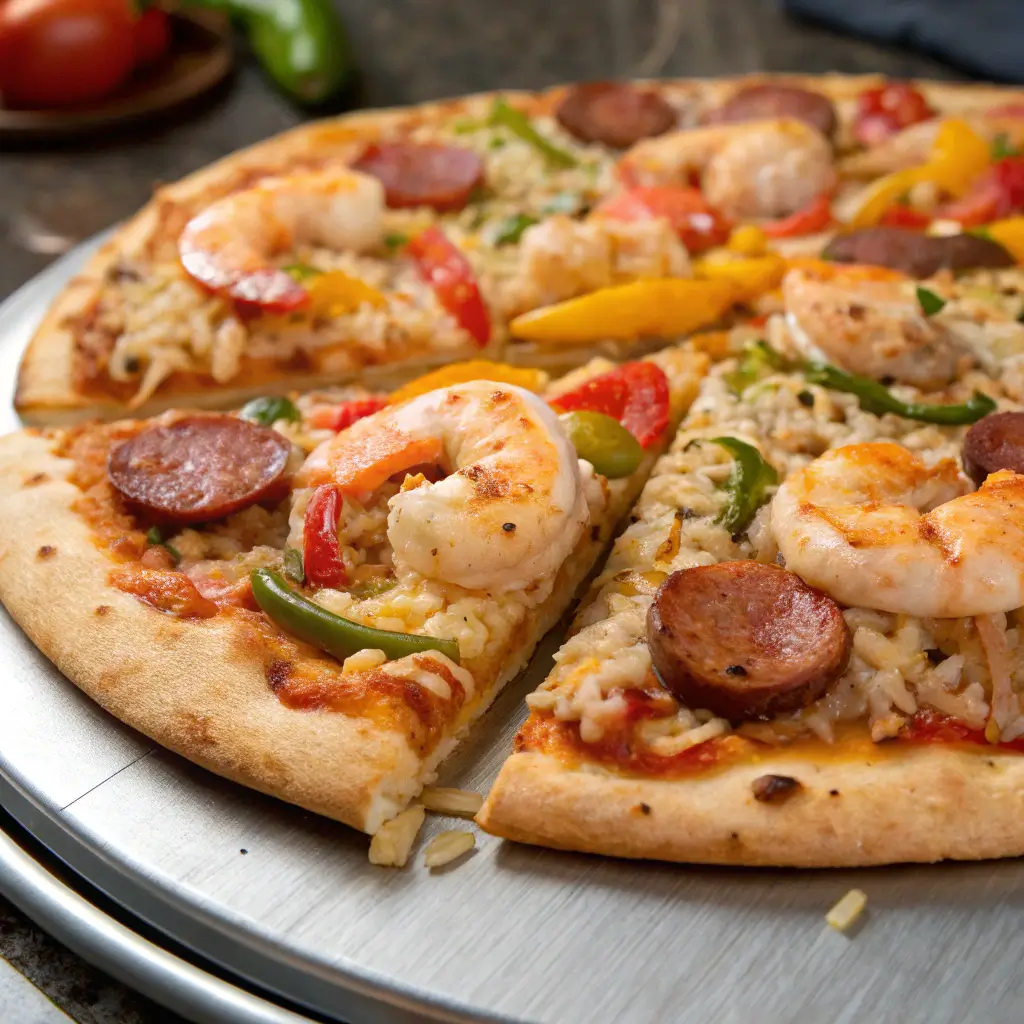Jambalaya Pizza: A Culinary Adventure Blending Cajun Heat and Italian Comfort
If you’re tired of the same old pizza toppings and crave a dish that dances on your taste buds, Jambalaya Pizza is your ticket to flavor town. This bold fusion marries the fiery soul of Louisiana’s jambalaya with the universal charm of pizza, creating a meal that’s as exciting to make as it is to eat. Whether you’re hosting a Mardi Gras-themed party or simply shaking up weeknight dinners, this recipe promises a delicious departure from the ordinary. Let’s explore how to craft this masterpiece, along with tips, twists, and the cultural magic behind it.
The Magic Behind the Fusion: Why Jambalaya and Pizza?
At first glance, jambalaya and pizza seem worlds apart. Jambalaya, a Louisiana staple, is a vibrant one-pot wonder featuring rice, smoky meats, seafood, and the “holy trinity” of Cajun cooking—onions, bell peppers, and celery. It’s a dish steeped in history, reflecting Spanish, French, and West African influences. Pizza, born in Naples, Italy, is a global icon of comfort, with its crispy crust, tangy sauce, and gooey cheese.
So, what happens when these two collide? A symphony of contrasts: spicy meets savory, crispy meets tender, and tradition meets innovation. The robust flavors of jambalaya—think andouille sausage, Cajun spices, and plump shrimp—shine atop a golden pizza crust, while melted cheese adds a creamy counterpoint. It’s a culinary handshake between New Orleans and Naples, proving that great food knows no borders.

Crafting Your Jambalaya Pizza: Ingredients & Tools
Before diving in, gather these essentials to build layers of flavor:
For the Pizza Crust
- 2½ cups all-purpose flour (or gluten-free blend for dietary needs)
- 1 packet of active dry yeast (equivalent to 2¼ teaspoons)
- 1 cup warm water (110°F—think “baby bottle warm”)
- 2 tablespoons of olive oil (with additional oil for greasing)
- 1 teaspoon each of sugar and salt
For the Jambalaya Topping
- 1 tbsp olive oil
- 1 cup andouille sausage (sliced; smoked sausage works too)
- 1 cup cooked chicken (shredded rotisserie chicken adds ease)
- 1 cup raw shrimp (peeled, deveined, tails off)
- 2 garlic cloves (minced)
- 1 small onion and 1 green bell pepper (finely chopped)
- 1 can diced tomatoes (14.5 oz; fire-roasted for extra depth)
- 1 tbsp Cajun seasoning (adjust to taste; Tony Chachere’s is a classic)
- ½ tsp smoked paprika + ½ tsp dried thyme + ½ tsp oregano
- Salt + black pepper
For Assembly
- 1 cup pizza sauce (spice it up with a dash of hot sauce)
- 1½ cups shredded mozzarella
- ½ cup shredded pepper jack cheese (for a kick)
- Fresh parsley or chopped green onions (to use as a garnish)
Tools You’ll Need
- Large mixing bowl + skillet
- Pizza stone or baking sheet
- Rolling pin (or, if needed, a olive oil bottle can work as a substitute!)
Step-by-Step Guide to Jambalaya Pizza Perfection
1. Wake Up the Yeast: Prepare the Dough
- Activate the Yeast: In a bowl, mix warm water, sugar, and yeast. Allow it to rest for 5–10 minutes until the mixture becomes frothy. Pro Tip: If the mixture doesn’t bubble, your yeast may be expired.
- Mix the Dough: Stir in flour, salt, and olive oil until a shaggy dough forms.
- Knead & Rest: Turn the dough onto a floured surface and knead for 5–7 minutes until smooth. Place in an oiled bowl, cover with a damp cloth, and let rise in a warm spot for 1–2 hours.
Shortcut Alert: Use store-bought dough or a pre-baked crust to save an hour.
2. Build the Jambalaya Topping
- Cook the Sausage: In a skillet, heat olive oil over medium heat and brown the sausage until fully cooked. Cook andouille slices until crispy. Remove and set aside.
- Sauté the Veggies: In the same skillet, cook onion, bell pepper, and garlic until softened (about 5 minutes).
- Simmer the Sauce: Add diced tomatoes, Cajun seasoning, paprika, thyme, oregano, salt, and pepper. Let it bubble for 5–7 minutes to thicken.
- Add Proteins: Stir in chicken, shrimp, and cooked sausage. Cook until shrimp turns pink (3–4 minutes). Pro Tip: Pat shrimp dry to avoid steaming.
3. Assemble & Bake
- Preheat & Prep: Crank the oven to 475°F (245°C). If you’re using a pizza stone, place it in the oven at this point to preheat.
- Shape the Crust: Roll risen dough into a 12–14-inch circle on a floured surface. Transfer to parchment paper.
- Layer It Up:
- Spread pizza sauce, leaving a ½-inch border.
- Evenly scatter half of the cheese over the surface.
- Add jambalaya topping (avoid excess liquid).
- Finish by evenly spreading the remaining cheese on top.
- Bake: Slide the pizza onto the stone or baking sheet. Bake 12–15 minutes until crust is golden and cheese bubbles.
- Garnish & Serve: Sprinkle with fresh parsley or green onions. Slice and enjoy!

Pro Tips for Flawless Results
- Avoid Soggy Crust: Drain diced tomatoes and pat shrimp dry before cooking.
- Spice Control: For mild palates, use half the Cajun seasoning. Add cayenne or hot sauce for extra heat.
- Cheese Hack: Blend mozzarella with smoked gouda for a richer flavor.
- Crispy Edge: Brush the crust with garlic butter before baking.
Creative Twists to Make It Your Own
- Vegetarian Delight: Swap meat for plant-based sausage, black beans, and extra veggies like zucchini or mushrooms.
- Seafood Lover’s Dream: Replace shrimp with crawfish or lump crab meat.
- Breakfast Pizza: Top with a fried egg and hot sauce for a brunch twist.
- Gluten-Free: Use a cauliflower crust or gluten-free flour blend.
Pairing Suggestions:
- Garlic Parmesan Knots: Perfect for dipping in leftover sauce.
- Simple Salad: Arugula with lemon vinaigrette cuts through the heat.
- Dirty Rice: Serve on the side for a true Louisiana feast.
The Cultural Tapestry Behind the Dish
Jambalaya’s roots trace back to 18th-century Louisiana, where Spanish colonists adapted paella using local ingredients. Enslaved Africans contributed okra and spices, while French settlers added their culinary techniques. The dish became a symbol of cultural resilience and community.
Pizza, meanwhile, evolved from ancient flatbreads to Naples’ 18th-century street food. Italian immigrants brought it to America, where it morphed into countless styles. Merging these two dishes isn’t just tasty—it’s a nod to how food evolves through shared history.
Storing & Reviving Leftovers
- Fridge: Store slices in an airtight container for up to 3 days.
- Freezer: Wrap uncooked assembled pizza in plastic and freeze for 2 months. Bake directly from the freezer, extending the cooking time by 5–7 minutes.
- Reheating: Use an oven (375°F for 10 minutes) or skillet for a crispy crust. Avoid microwaving—it turns crust rubbery!
Why This Recipe Wins
Jambalaya Pizza isn’t just a meal; it’s a conversation starter. It respects tradition while embracing creativity, allowing home cooks to play with flavors. The spicy, smoky jambalaya melds seamlessly with pizza’s cheesy comfort, offering a bite that’s both nostalgic and novel. Plus, its adaptability means everyone—from meat lovers to vegans—can join the party.
Final Word: Embrace the Fusion
In a world where culinary boundaries are blurring, Jambalaya Pizza stands as a testament to innovation. It’s a dish that invites you to experiment, share, and savor. So, roll up your sleeves, crank up some jazz or Italian opera, and let your kitchen become the crossroads of Cajun and Italian flair. Your taste buds—and dinner guests—will thank you.
For healthy recipes checkout our blog healthyrecipees.com
